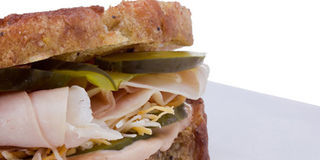Good cholesterol, bad cholesterol

A sandwich with meat, pickles, cheese, and sauce on a white plate. Cholesterol is an essential part of many important hormones, including oestrogen, progesterone and testosterone. Photo/AFP
We often hear warnings about cholesterol. However, your body actually needs some cholesterol to stay healthy. This article will explain the different types of cholesterol and what you can do to keep your levels healthy.
What is cholesterol?
Cholesterol is a type of fat. It’s found in all the cells in your body and forms part of their outer layer. Cholesterol is also an essential part of many important hormones, including oestrogen, progesterone and testosterone.
There are two main types of cholesterol.
• Low-density lipoprotein (LDL) cholesterol is also known as ‘bad’ cholesterol. High levels of LDL cholesterol can lead to atherosclerosis – a process in which fatty deposits build up on the walls of your arteries.
This can reduce or block the blood flow in your arteries and lead to heart disease or a stroke.
• High-density lipoprotein (HDL) cholesterol is also known as ‘good’ cholesterol. It carries excess cholesterol out of your blood to your liver, where it’s processed and removed from your body.
Your risk of heart disease and stroke is particularly high if you have high levels of LDL cholesterol and low levels of HDL cholesterol.
Sources of cholesterol
There are two different sources of cholesterol – some comes from the food you eat, but most of it is made within your body.
Cholesterol that comes from the food you eat is called dietary cholesterol. Not many foods actually contain cholesterol. Examples of some that do are:
• eggs
• liver
• kidney
• prawns
If you eat foods that are high in cholesterol, it won’t usually raise your blood cholesterol level much. Most cholesterol is made within your body, in your liver. Your liver can produce all of the cholesterol your body needs so dietary cholesterol isn’t an essential part of your diet. Your cholesterol levels are mainly influenced by the other fats that you eat.
Saturated fats
The saturated fats you eat have the biggest impact on cholesterol levels in your body. Saturated fats cause levels of LDL cholesterol to rise in your blood, in proportion to HDL cholesterol.
This can increase your risk of heart disease or stroke. It’s important to limit the amount of saturated fats you eat – most of us eat too many. Saturated fats are found in foods such as meat, cheese, butter, cream, cakes, biscuits and pastries.
Unsaturated fats
Unsaturated fats actually reduce levels of LDL cholesterol in your blood. For this reason they can be a healthy choice, and it's a good idea to replace saturated fats in your diet with unsaturated fats. Unsaturated fats are found in vegetable oils, sunflower spreads, nuts and avocados.
Trans fats
Trans fats are artificially solidified vegetable oils. Similar to saturated fats, trans fats raise levels of LDL cholesterol, so try to save foods that contain these for an occasional treat. Trans fats are found in many types of processed foods, including biscuits, cakes and pastries.
Your cholesterol level
A doctor can measure your cholesterol level with a blood test. The World Health Organization classifies a raised cholesterol level as having a total cholesterol higher than 5 millimoles per litre (mmol/l) or 190 milligrams per decilitre (mg/dL).
However, when you get your result, your doctor will also consider your personal circumstances, as it’s important to remember that as well as your cholesterol level, other factors such as smoking, your weight and high blood pressure increase your risk of heart disease and stroke.
If you have high cholesterol, you can help to lower it by changing your diet and maintaining a healthy weight. Your diet should be low in fat overall and particularly low in saturated fats. It's also important to eat plenty of fibre, especially soluble fibre, which is thought to lower cholesterol levels. Soluble fibre is found in fruit, beans and oats.
If you're overweight, try to lose excess weight as it may help to reduce your LDL cholesterol levels and increase your HDL levels. If you increase your physical activity, it may also help to raise your HDL levels.
If you already have heart disease or are at a high risk of getting it, your doctor may prescribe cholesterol-lowering medicines, such as statins or fibrates.
There are some specially-designed food products (for example, some spreads and yoghurts) that are aimed at people who need to lower their cholesterol levels.
These foods contain added ingredients, such as substances produced by plants called sterols and stanols, which may help lower your blood cholesterol levels.
If you choose to use these products, always read the label and make sure that you don’t eat too much. If you don’t have high cholesterol levels, it’s best not to eat these products too often, particularly if you’re pregnant or breastfeeding. Also, don’t give them to children under the age of five.
There are also specific diets that can help to lower your cholesterol, such as the ultimate cholesterol lowering plan. This involves eating a diet that is low in saturated fat and high in plant-based foods that can lower cholesterol – examples include nuts (unsalted peanuts, cashews and almonds, for example) and soya protein.
It’s important to ensure that you still eat a healthy balanced diet that incorporates all the major food groups. Ask your doctor or a dietitian for more information on diets to help lower cholesterol.


